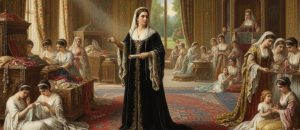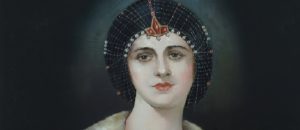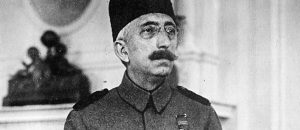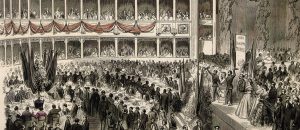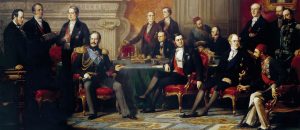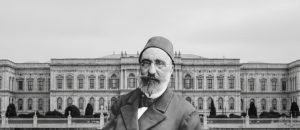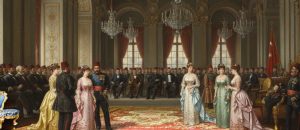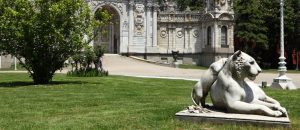Sultan Abdülaziz is the Sultan who transformed Dolmabahçe Palace from merely an administrative center and residence into a living art gallery and a cultural ambassador engaging in dialogue with the West. His personal passion for art, especially painting and music, and his historic European journey in 1867, triggered a cultural revolution that adorned the palace walls with the works of international artists. During the reign of Sultan Abdülaziz, Dolmabahçe became a stage showcasing not only political power but also the Ottoman Empire’s changing aesthetic taste and artistic claim. (Link: The Dynasty and Residents of Dolmabahçe -> /learn/the-dynasty-and-its-people)
The Sultan’s Brush and Notes: An Artist Ruler
Unlike many sultans who preceded and succeeded him, Sultan Abdülaziz was not merely a consumer of art but also a producer. It is known that he was a good painter, drawing charcoal and oil sketches. Also a composer who created Western-style musical works, the Sultan was a figure who personally practiced art, going beyond mere patronage within the palace. This personal interest formed the basis of his policy to use art as a means of state prestige and modernization. For him, art was the strongest evidence that the empire could integrate culturally with the West as well.
This vision brought about a radical change in the palace’s decoration. Traditional calligraphy and tezyinat (ornamentation) began to be replaced by canvas paintings and sculptures in the Western sense. To realize this transformation, Sultan Abdülaziz both supported local artists and invited Europe’s most famous artists to Istanbul or commissioned works from them.
The Historic European Journey and Artistic Interaction
The turning point in Sultan Abdülaziz’s reign and Dolmabahçe’s cultural transformation was his historic European journey undertaken in 1867. Sultan Abdülaziz, who was the first and only Ottoman Sultan to travel to the West, visited art capitals such as Paris, London, and Vienna. During this journey, he toured the Paris International Exhibition, conducted observations in museums like the Louvre, and personally witnessed the rich art collections in the palaces of his European counterparts.
This journey profoundly affected the Sultan’s art vision. The splendor he saw in Europe further encouraged him to equip Dolmabahçe Palace with art works of similar quality. Immediately after the journey, he launched a major initiative to enrich the palace’s art collection. This was not merely an aesthetic pursuit, but also a strategy to reinforce the Ottoman Empire’s international reputation through art. (Link: Ottoman Empire’s international reputation -> /mermerden-daha-fazlasi-dolmabahce-mimarisi-neden-avrupaya-gonderilmis-bir-mesajdi)
Palace Painters of the Court: Ayvazovsky and Others
One of the most concrete results of Sultan Abdülaziz’s artistic initiative was the personal relationships he established with famous artists of the period and the commissions he gave them. The most prominent name among these artists is the Russian marine (marina) painter Ivan Ayvazovsky. Ayvazovsky was invited to Istanbul multiple times by the Sultan and was given the title “Palace Painter“. Sultan Abdülaziz requested Ayvazovsky to paint not only Bosphorus and Istanbul landscapes but also canvases depicting the victories of the Ottoman fleet. The dozens of Ayvazovsky paintings located today in the National Palaces Painting Museum collection are the result of this productive collaboration. The Sultan wanted to immortalize both the beauties and the military might of the empire with Ayvazovsky’s brush.
Ayvazovsky was not the only artist patronized by Sultan Abdülaziz. The Polish painter Stanisław Chlebowski also served in the palace for many years and produced large compositions focusing on Ottoman history, particularly conquest scenes. The sculpture commissioned from the French sculptor Pierre-Louis Guillemin, depicting Sultan Abdülaziz on horseback (exhibited today in Beylerbeyi Palace), is one of the most important examples of the artistic audacity of this era.
The Revolution on the Wall: Transition from Miniature to Canvas
These moves by Sultan Abdülaziz constituted a revolution in Ottoman palace art. The miniature tradition, which had dominated palace art for centuries, limited to book pages, and containing non-figurative or stylized figures, was replaced by large-sized canvas paintings using Western painting techniques like perspective and chiaroscuro (light and shadow). (Link: Details of this artistic revolution -> /duvardaki-devrim-dolmabahcenin-tablo-koleksiyonu-minyaturu-nasil-tarihe-gomdu) Dolmabahçe’s enormous walls offered a perfect display area for this new artistic understanding. The palace halls were no longer just administrative spaces but also art galleries, and these galleries showcased the modernizing face of the Ottoman Empire to the whole world.
Conclusion
In conclusion, Sultan Abdülaziz transformed Dolmabahçe Palace into a center of culture and art thanks to his personal passion for art and his visionary European journey. Under his patronage, the palace was enriched with the works of international masters like Ayvazovsky and hosted a radical revolution in Ottoman art, such as the transition from miniature to canvas. By using art as a tool for diplomacy and modernization, Sultan Abdülaziz elevated Dolmabahçe beyond merely a center of power; he made it a living cultural ambassador whose walls spoke with the West.








